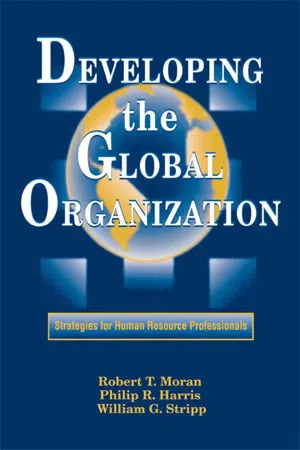Marketing
Global Marketing
Global marketing refers to the strategy of promoting and selling products or services on a worldwide scale. It involves understanding different cultures, consumer behaviors, and market trends in various countries to tailor marketing efforts accordingly. Global marketing often requires adapting products, pricing, distribution, and promotional strategies to fit the specific needs and preferences of diverse international markets.
Written by Perlego with AI-assistance
Related key terms
1 of 5
10 Key excerpts on "Global Marketing"
- eBook - PDF
- Sharma, Premjit(Authors)
- 2021(Publication Date)
- Genetech(Publisher)
1 Introduction to Global Marketing Marketing is the process of building lasting relationships through planning, executing and controlling the conception, pricing, promotion and distribution of ideas, goods and services to create mutual exchange that satisfy individual and organisational needs and objectives. The long held tenants of marketing are “customer value”, “competitive advantage” and “focus”. This means that organisations have to study the market, develop products or services that satisfy customer needs and wants, develop the “correct” marketing mix and satisfy its own objectives as well as giving customer satisfaction on a continuing basis. However, it became clear in the 1980s that this definition of marketing was too narrow. Preoccupation with the tactical workings of the marketing mix led to neglect of long term product development, so “Strategic Marketing” was born. The focus was shifted from knowing everything about the customer, to knowing the customer in a context which includes the competition, government policy and regulations, and the broader economic, social and political macro forces that shape the evolution of markets. In Global Marketing terms this means forging alliances (relationships) or developing networks, working closely with home country government officials and industry competitors to gain access to a target market. Also the marketing objective has changed from one of satisfying organisational objectives to one of “stakeholder” benefits—including employees, society, government and so on. Profit is still essential but not an end in itself. Strategic marketing is the initiating, negotiating and managing acceptable exchange relationships with key interest groups or constituencies, in the pursuit of sustainable competitive advantage within specific markets, on the basis of long run consumer, channel and other stakeholder franchise. - eBook - ePub
The Official CIM Coursebook
Strategic Marketing Decisions 2008-2009
- Isobel Doole, Robin Lowe(Authors)
- 2012(Publication Date)
- Routledge(Publisher)
Bd.1 Promote a strong market orientation and influence/contribute to strategy formulation and investment decisions.Bd.2 Specify and direct the strategic marketing planning process.Cd.1 Promote organization-wide innovation and cooperation in the development of brands.Key definitionsExport marketing – the marketing of goods and/or services across national/political boundaries.Multinational marketing – the marketing activities of an organization that has activities, interests or operations in more than one country and where there is some kind of influence or control of marketing activities from outside the country in which the goods or services will actually be sold, but where the global markets are primarily perceived to be independent markets and profit centres in their own right.Global Marketing – where the whole organization focuses on the selection and exploitation of Global Marketing opportunities and marshalls resources around the globe with the objective of achieving a global competitive advantage.Study guide
This unit is concerned with making strategic marketing decisions in the global context to exploit new opportunities in the global market through leveraging capability and sharing learning. Organizations adopt different approaches depending on their resources, ambition and market context. Understanding the factors that have contributed to globalization is essential in understanding how the very largest firms grow. It is important too to recognize the times when activities can be standardized or should be adapted for local markets. Smaller firms also succeed in global markets provided that they take appropriate decisions on strategic approaches for their situation, for example niche marketing. In both large and small firms we also emphasize the importance of corporate learning to ensure that the lessons learned in the market can be shared as widely as possible. - eBook - PDF
- Joao Heitor De Avila Santos(Author)
- 2019(Publication Date)
- Society Publishing(Publisher)
It is merely after careful study of these International Business Strategy 140 “globes” a truly global strategy can be designed and effectively implemented. Unity in variety is indeed the key principle of standard systems theory. The world can be regarded as a wide-open system made up of many subsystems, each which has its images, dreams, inspirations, goals, and goals to perform (Kanishchenko, 2004). A global online marketing strategy incorporates the normal attributes of lots of the subsystems. Trying to sell a product internationally Simply because it includes successfully satisfied the house country’s needs is not globalism; somewhat, it is ethnocentrism—the self-centered and mistaken assumption that what’s best for one’s own region or people, the “ethnos,” is wonderful for all of that other world. 9.2 THE FUNDAMENTALS OF MARKETING Although marketing function of a business is actually the same if the market is local or international, there are numerous adaptations that must definitely be carried out when certain key ideas and/or techniques are taken overseas. The North American Marketing Relationship, cognizant of the changes that contain occurred in the idea of marketing, has approved a fresh broader classification of marketing. Marketing is thought as the procedure of planning and performing the conception, charges, promotion, and circulation of ideas, goods, and services to setup exchanges that gratify person and organizational aims. Two concepts stick out in this description. First, you can find the theory that the look and execution connect not and then products but also to ideas and services. The brand-new definition stresses that marketing entails much more than simply retailing goods. Second, there exists the idea that the present day marketing function is definitely a strategic subject for the reason that it plays a part in the overall tactical mission of the business. - eBook - ePub
Global Marketing
Practical Insights and International Analysis
- Carlyle Farrell(Author)
- 2015(Publication Date)
- SAGE Publications Ltd(Publisher)
In today’s business environment, firms may face competition from companies located in their own home market as well as from those based halfway around the world. Also, customer trends which take root in one country may quickly spread to other parts of the world, creating either new marketing opportunities or potential threats to a firm’s established products and business models. In addition, political and economic crises in one region may have important implications for consumer and business confidence around the world. One need look no further than the sovereign debt crisis in Europe that began to unfold in 2009 or the sub-prime mortgage crisis in the USA that first came to light some two years earlier, to appreciate the impact of such events on economic growth, consumer spending and prosperity. Economic and political events taking place around the world may have a profound effect on a company’s prospects for survival and growth. It should be noted that whether or not a firm elects to operate internationally, it is still vulnerable to changes taking place in the global marketplace. A focus only on its domestic market does not make a firm immune to global competitive pressures or exogenous shocks that stem from political and economic events originating outside the borders of its home country.This text will introduce you to the field of Global Marketing. As you read through the following chapters, you will learn how to identify opportunities in foreign markets and develop effective strategies to capitalize on those opportunities. You will begin to appreciate the cultural differences between consumers in your home market and those in markets around the world, and you will learn how those differences impact a company’s ability to succeed abroad. You will also learn how to formulate and execute effective marketing strategies in foreign countries while mitigating the political and economic risks involved in doing business abroad.The study of Global Marketing is as exciting as it is important. For many firms based in developed countries, penetrating fast-growing emerging markets such as India and China is a matter of survival. The mature markets of Western Europe and North America offer little prospect for rapid growth with their aging populations and low population growth rates. Firms operating in these established markets also face intense competitive pressures which effectively limit expansion possibilities. These competitive pressures, it should be noted, come not only from established western firms but also from emerging market multinationals headquartered in countries such as Brazil, China and India.In some cases, firms may be forced to adopt a Global Marketing perspective simply based on the nature of their products. High research and development (R&D) costs involved in bringing some pharmaceutical drugs to market, for example, necessitate that they be marketed globally if those costs are to be recouped. There is considerable debate around the cost of developing new pharmaceutical drugs. Indeed, one recent study estimated the cost at over $1 billion.1 - eBook - PDF
Principles of Marketing
A Value-Based Approach
- Ayantunji Gbadamosi, Ian Bathgate, Sonny Nwankwo(Authors)
- 2013(Publication Date)
- Bloomsbury Academic(Publisher)
International marketing strategy is simply about putting all the building blocks together – making both short-term and long-term decisions that lead a firm to achieve its international marketing goals. By and large, these decisions revolve around the controllable elements of the marketing environment, largely the marketing mix. In summary, elements of international marketing strategy comprise: ● Product strategy: Decisions about which product (tangible or intangible) to offer to the market in order to satisfy the customer ● Pricing strategy: Decisions about how to set a profitable and justifiable process ● Distribution strategy: Decisions about how to get products to reach the consumers who need those products, where and when they want them ● Promotional strategy: Decisions about promotional tools to connect customers 356 marketing in a global context effectively with the company and its products ● Segmentation and targeting strategy: Customer-oriented marketing begins with a clear understanding of the customer group(s) to serve, their unique needs and values Standardization and differentiation The controversy over whether firms should standardize their products for interna-tional marketing purposes or customize for specific markets has been ongoing for some time. There are advantages and disadvantages in each approach and it seems the only agreement is that firms should standardize as much as possible to achieve scale economies and increased factor effi ciency whilst providing as much differentia-tion as the foreign market needs (Maktoba and Nwankwo, 2009). Highly competitive international firms guard their supply chain jealously and often source factor inputs from fewer suppliers that are integrated with their control processes. The quest for international competitiveness in many cases instigates a strategy of standardization. - eBook - ePub
- Geoffrey Lancaster, Lester Massingham(Authors)
- 2017(Publication Date)
- Routledge(Publisher)
This chapter seeks to address some of these key issues and skills required when managing marketing programmes in international markets. It is important to stress that this chapter only gives an overview of the issues and skills associated with international marketing management. As such, we are focused on what we believe to be some of the key contemporary issues in international marketing and some of the key decision areas and considerations when developing marketing strategies in these markets. Students and managers who are interested in acquiring a more detailed knowledge in this area are advised to consult one of the specialist texts in this increasingly complex region of marketing. We start by examining some of the background to the growth in international trade and marketing and some of the reasons put forward as to why companies and nations become involved in such activities.The growth of international/Global Marketing
One of the most striking business trends of the past 40 years has been the increase in internationalization: that is, the growing number of firms that participate in international trade. Of course, international trade is not new; after all, nations have traded ever since the start of commerce. However, the 1990s was really the first decade when companies around the world started to think globally. It was during the 1990s that time and distance, dimensions that have been shrinking for centuries between countries, began to become really compressed. The advent of ever faster transport and communication systems, which in turn have led to vastly increased travel and more cosmopolitan consumers, have served to ‘shrink’ the world even further, so much so that writers now refer to the so-called ‘global village’. Needless to say, in this millennium this shrinking will continue, aided principally by the Internet.Although companies such as Nestlé, IBM, Shell, Toshiba and others have been conducting international marketing for decades, global competition has now intensified to the extent that even purely ‘domestic companies’ that have hitherto never thought about international marketing are affected in their marketing by global competitors.In addition, the importance of international trade to governments and to countries’ economies has meant that more and more firms are being urged to internationalize, thereby selling more of their products abroad and as a consequence adding positively to the balance of payments. This ‘urging’ has resulted in many governments offering material encouragement to companies to become more involved in international marketing in the form of, for example, grants, loans and offers of expert advice. Finally, global markets themselves have changed and are changing with developments such as the enlarged and more co-ordinated European Union and the adoption within it by a majority of the member states of a single currency. The development of the so-called ‘tiger economies’ of the Pacific rim, and the collapse of Communism and the ensuing growth of more liberal economies in Eastern Europe – many now having joined the EU – have given rise to significant new opportunities for companies that have been willing and able to take advantage of them and threats for those who have not. These and other developments largely explain the increased activity and importance of international marketing, but do not, of themselves, explain the basic reasons and motives for companies becoming involved in international markets. It is useful in our understanding of international markets management to identify some of these key underpinning reasons and motives. - eBook - PDF
Dynamics of International Advertising
Theoretical and Practical Perspectives
- Barbara Mueller(Author)
- 2017(Publication Date)
T he primary focus of this text is international advertising However, because an advertising campaign is part of an overall marketing strategy and must be coordinated with other marketing activities, the role of the other marketing mix elements will be reviewed Companies operating in one or more foreign markets must decide whether to adapt their marketing mix to local conditions, and if so, to what degree The concept of a marketing mix, popularized by Jerome McCarthy, includes the following four P’s: • Product: includes a product’s design and development, as well as branding and packaging; • Place (or distribution): includes the channels used in moving the product from manufacturer to consumer; • Price: includes the price at which the product or service is offered for sale and establishes the level of profitability; • Promotion: includes advertising, personal selling, sales promotions, direct marketing, and publicity Broadly defined, it also includes sponsorships, product integration, and even trade fairs (McCarthy 1960) Globalization Versus Localization of The Marketing Mix Experts continue to disagree over the degree to which firms should globalize, or standardize, their marketing programs across markets At one extreme are companies that support the use of a fully standardized approach Marshall McLuhan coined the term “global village” to describe an emerging world tightly linked through telecommunications Many marketers believe that these advances in telecommunications, along with cheaper air transportation and the resulting increase in international travel, have created increasingly international consumers, making the world ripe for Global Marketing— at least for selected products This concept is not new Debates regarding the viability of Global Marketing surfaced as far back as the late 1960s (Buzzell 1968) However, the concept was popularized by Harvard marketing professor C HA P T ER 2 The International Marketing Mix - eBook - ePub
- William G. Stripp, J.D., Philip R. Harris, Robert T. Moran(Authors)
- 2012(Publication Date)
- Routledge(Publisher)
The basic purpose of advertising is to effectively communicate information and persuade consumers to purchase a product or service. If cross-cultural advertising is skillfully planned and implemented, it can introduce desirable new products, combat foreign competition, build goodwill, and promote sales. Skillful planning of cross-cultural advertisements requires marketeers to learn about foreign audiences, define market segments as precisely as possible, and study backgrounds and motivational influences in detail before the advertising campaign is formulated.Cross-cultural advertising campaigns can be categorized as either multinational or global. Multinational advertisers feel that cultural differences play an important part in shaping demand for the specific types of goods and services and in determining what promotional appeals are best. Therefore they pay strict attention to cultural differences world-wide. Factors such as geography, language, religion, philosophy, tradition, and family patterns are all considered when designing the multinational advertising campaign.Although most corporations formerly relied on multinational ad campaigns, global advertising is beginning to be taken much more seriously. For a long time, the marketing world did not have the international coordination to pursue a single idea worldwide, and local cultural differences seemed too great a chasm to try to bridge. However, in the 1980s many corporations began to make the same brand names available worldwide. Giant advertising networks arose to take the global accounts.There are many reasons to attempt global advertising campaigns, but the most compelling are money and control. Global advertising can save money on commercial production costs and allow corporations to retain greater control over the message and content of advertisements than was previously possible.While there are economies of scale in using the same advertising programs worldwide, there are four major problems in the global standardization of advertising: (1) translation, (2) legality, (3) credibility or image, and (4) media availability. These problems have resulted in very few global campaigns. Instead, most standardized campaigns rely upon similar types of advertisements. For example, using sports stars from every country to advertise a soft drink. - eBook - PDF
- Barton A Weitz, Robin Wensley, Barton A Weitz, Robin Wensley(Authors)
- 2002(Publication Date)
- SAGE Publications Ltd(Publisher)
Gad, Thomas (2001) 4-D Branding . London: Financial Times/Prentice-Hall. Gates, Stephen (1995) The changing global role of the marketing function: a research report. The Conference Board, report no. 1105-95-RR. Gatignon, Hubert, Eliashberg, Jehoshua & Robertson, Thomas S. (1989) Modeling multinational diffusion patterns: an efficient methodology. Marketing Science , 8, Summer, 231–47. Goldman, Arieh (1974) Outreach of consumers and the modernization of urban food retailing in developing countries. Journal of Marketing , 38, October, 8–16. Graber, D.R. (1996) How to manage a global product development process. Industrial Marketing Manage-ment , 25, 6, 483–9. Graham, John L., Mintu, Alma T. & Rodgers, Waymond (1994) Explorations of negotiations behaviors in ten foreign cultures using a model developed in the United States. Management Science , 40, 1 (January), 72–95. Hakansson, Hakan (1989) Corporate Technological Behaviour: Cooperation and Networks. London: Routledge. Hall, Edward T. (1976) Beyond Culture . Garden City, NY: Anchor. Hall, Edward T. & Hall, Mildred Reed (1990) Understanding Cultural Differences . Yarmouth, ME: Intercultural Press. Halliburton, Chris & Huenerberg, Reinhard (1993) Pan-European marketing – myth or reality? Journal of International Marketing , 1, 3, 77–92. Halliburton, Chris & Jones, Ian (1994) Global individual-ism – reconciling Global Marketing and global manu-facturing. Journal of International Marketing , 2, 4, 79–88. Hamel, Gary & Prahalad, C.K. (1991) Corporate imagina-tion and expeditionary marketing. Harvard Business Review , July–August, 81–92. Han, C. Min & Terpstra, Vern (1988) Country-of-origin effects for uni-national and bi-national products. Journal of International Business Studies , 19, 2, 235–55. Hanni, David A., Ryans, John K. & Vernon, Ivan R. (1995) Coordinating international advertising – the Goodyear case revisited for Latin America. - eBook - PDF
- Michael Czinkota, Ilkka Ronkainen, Annie Cui, , Michael Czinkota, Ilkka Ronkainen, Annie Cui(Authors)
- 2022(Publication Date)
- Cengage Learning EMEA(Publisher)
24 ● The product’s positioning. For example, Parker Pen’s upscale image may not be profitable enough in a market that is more or less a commodity business. The solution is to create an image for a commodity product and make the public pay for it. SOURCE: Courtesy of National Geographic Channels International. Exhibit 13.11 Example of a Panregional Medium Copyright 2023 Cengage Learning. All Rights Reserved. May not be copied, scanned, or duplicated, in whole or in part. Due to electronic rights, some third party content may be suppressed from the eBook and/or eChapter(s). Editorial review has deemed that any suppressed content does not materially affect the overall learning experience. Cengage Learning reserves the right to remove additional content at any time if subsequent rights restrictions require it. 376 Part Three: The Global Marketing Mix The ideal situation in developing message strategy is to have a world brand—a product that is manufactured, packaged, and positioned the same around the world. Companies that have been suc-cessful with the global approach have shown flexibility in the execution of the campaigns. The idea may be global, but overseas subsidiaries then tailor the message to suit local market conditions and regulations. Executing an advertising campaign in multiple markets requires a balance between con-veying the message and allowing for local nuances. The localization of global ideas can be achieved by various tactics, such as adopting a modular approach, localizing international symbols, and using international advertising agencies. An example of local adjustment in a global campaign for Toyota is provided in Exhibit 13.13. Marketers may also want to localize their international symbols. Some of the most effective global advertising campaigns have capitalized on the popularity of pop music worldwide and used well-known artists in the commercials, such as Lady Gaga, Beyoncé, and Shakira.
Index pages curate the most relevant extracts from our library of academic textbooks. They’ve been created using an in-house natural language model (NLM), each adding context and meaning to key research topics.









